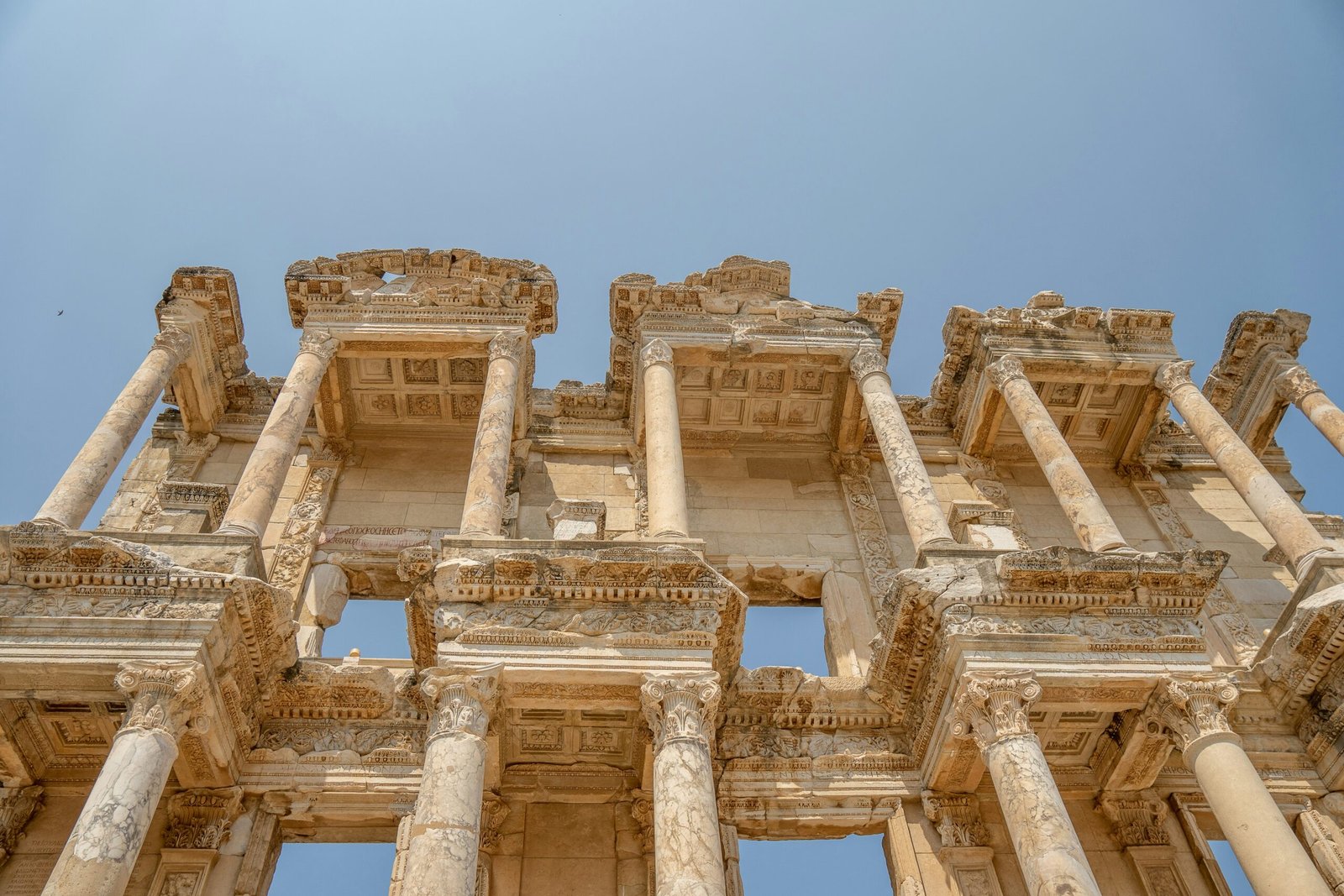
The Library of Celsus was built in the 2nd century AD as a mausoleum for Gaius Julius Celsus Polemaeanus, a Roman senator and consul. However, it was later converted into a library, housing over 12,000 scrolls and serving as a center of knowledge and education in the ancient world. The library was not only a repository of books but also a symbol of wealth and power, showcasing the intellectual and cultural achievements of the Roman Empire.
The design of the Library of Celsus is a perfect blend of Roman and Greek architectural styles. The facade of the building is adorned with intricate carvings and statues, depicting various gods, goddesses, and mythological figures. The two-story structure features a grand entrance with columns and a monumental staircase, leading to the main reading room on the upper floor.
Inside the library, the shelves were lined with beautifully crafted wooden cabinets, each containing meticulously cataloged scrolls. The reading room was a haven for scholars and intellectuals, providing a serene and quiet environment for studying and research. The walls were decorated with colorful frescoes and adorned with statues of famous philosophers and writers, inspiring visitors with the pursuit of knowledge.
Unfortunately, the Library of Celsus suffered significant damage over the centuries. In the 3rd century AD, a devastating earthquake struck Ephesus, causing the collapse of the facade and destroying a significant portion of the building. The library was later reconstructed to some extent but never regained its former glory.
Today, the Library of Celsus stands as a magnificent ruin, attracting thousands of visitors from around the world. Its grandeur and architectural beauty continue to captivate the imagination, offering a glimpse into the intellectual and cultural achievements of the ancient world. The site has been meticulously restored and preserved, allowing visitors to appreciate the splendor of this ancient library.
Visiting the Library of Celsus is a truly awe-inspiring experience. As you walk through the ruins, you can’t help but feel a sense of wonder and admiration for the ancient civilizations that once thrived in this remarkable city. The library serves as a reminder of the importance of knowledge and education, transcending time and reminding us of the enduring power of human intellect.
The Library of Celsus quickly became a center of intellectual and cultural life in Ephesus. Scholars and philosophers from all over the Roman Empire would flock to the library to study and exchange ideas. The collection of scrolls housed within its walls covered a wide range of subjects, including philosophy, history, mathematics, and literature.
Not only was the Library of Celsus a place of learning, but it also served as a symbol of the power and prestige of the Roman Empire. The grandeur of its architecture and the opulence of its decorations were a testament to the wealth and sophistication of the city of Ephesus. The statues and carvings that adorned the exterior of the library depicted various gods, goddesses, and mythological figures, further emphasizing the connection between knowledge and divine wisdom.
Unfortunately, the Library of Celsus did not stand the test of time. In the 3rd century AD, a devastating earthquake struck Ephesus, causing significant damage to the library. The structure was partially rebuilt, but it never regained its former glory. In the centuries that followed, the library fell into disrepair and was eventually abandoned.
Today, only the facade of the Library of Celsus remains standing. Despite its ruined state, the library continues to be a popular tourist attraction, drawing visitors from around the world who are captivated by its rich history and architectural beauty. The surviving fragments of the library serve as a reminder of the importance of knowledge and the enduring legacy of the ancient world.
The Library of Celsus, located in the ancient city of Ephesus, was not only a magnificent architectural feat but also a testament to the grandeur and sophistication of Roman design. The fusion of Greek and Roman elements in its construction created a unique and visually striking structure that still captivates visitors to this day.
The Corinthian columns that embellish the facade of the library are a hallmark of Roman architectural style. These two-story columns, with their ornate capitals adorned with acanthus leaves, exude a sense of elegance and grandeur. The entablature, which rests on top of the columns, features a frieze of intricately carved reliefs depicting various scenes from mythology and Roman history. These reliefs not only added aesthetic appeal but also served as a visual narrative, showcasing the cultural and historical significance of the Roman Empire.
As one approaches the entrance of the library, they are greeted by a grand staircase that leads to the main entrance. This staircase is flanked by statues representing the four virtues: Sophia (Wisdom), Ennoia (Thought), Episteme (Knowledge), and Arete (Virtue). These statues, meticulously crafted and placed strategically, symbolize the importance of knowledge and wisdom in Roman society. They serve as a reminder to all who enter the library of the pursuit of intellectual enlightenment.
Stepping inside the Library of Celsus, one is transported to a world of intellectual exploration and scholarly pursuits. The interior of the library consists of three main rooms, each serving a specific purpose. The central room, known as the nave, housed the majority of the scrolls and books. This spacious area was designed to accommodate a vast collection of knowledge, reflecting the Roman Empire’s commitment to education and learning.
The side rooms of the library were used for administrative purposes and for storing valuable manuscripts. These rooms, although smaller in size, were no less impressive in their design and craftsmanship. The walls of these rooms were adorned with beautiful frescoes depicting scenes from Greek mythology and Roman history. The intricate mosaics on the floors added to the overall splendor of the interior, showcasing the artistic prowess of the Roman Empire.
The Library of Celsus stands as a testament to the architectural and design brilliance of the Roman Empire. Its fusion of Greek and Roman elements, coupled with its intricate detailing and artistic embellishments, make it a truly remarkable structure. It serves as a reminder of the importance of knowledge and the pursuit of wisdom, values that were deeply ingrained in Roman society. Visiting this ancient library is not only a journey back in time but also a celebration of human intellect and the enduring power of ideas.
Importance and Legacy
The Library of Celsus played a significant role in the intellectual and cultural life of Ephesus. It served as a center for learning and scholarship, attracting scholars and philosophers from all over the Roman Empire. The library was not only a repository of knowledge but also a symbol of the city’s wealth and prestige.
With its vast collection of scrolls and books, the Library of Celsus became a hub of intellectual activity. Scholars would gather here to study, debate ideas, and exchange knowledge. It was a place where the great minds of the time could come together and push the boundaries of human understanding.
Moreover, the library was a testament to the wealth and power of Ephesus. Its grand architecture and intricate design showcased the city’s prosperity and cultural sophistication. The facade, adorned with statues and intricate carvings, was a sight to behold and a symbol of the city’s greatness.
Unfortunately, the Library of Celsus suffered significant damage over the centuries. In the 3rd century AD, a devastating earthquake destroyed much of the structure, leaving only the facade standing. The library remained in ruins for centuries until restoration efforts began in the 1970s.
The meticulous restoration work aimed to recreate the library’s former glory. Archaeologists and historians meticulously pieced together the fragments of the original structure, using ancient texts and drawings as a guide. Today, visitors can marvel at the restored facade, which stands as a testament to the resilience and determination of those who sought to preserve this important piece of history.
Today, the Library of Celsus stands as one of the most popular tourist attractions in Turkey, drawing visitors from all over the world. Its grandeur and architectural beauty continue to captivate and inspire, reminding us of the rich history and cultural heritage of Ephesus.
Moreover, the library’s legacy extends beyond its physical presence. It serves as a reminder of the importance of knowledge and education in society. The Library of Celsus embodies the belief that access to information and the pursuit of learning are fundamental to the progress of civilization.
Furthermore, the library’s influence can be seen in the modern world. Libraries today continue to serve as centers of learning and intellectual exchange. They provide access to a vast array of information and resources, fostering education and personal growth. The Library of Celsus, with its rich history and enduring legacy, serves as a timeless inspiration for the libraries of today and the future.
Visiting the Library of Celsus
If you’re planning a trip to Ephesus, a visit to the Library of Celsus is a must. The ancient city of Ephesus is located near the modern-day town of Selçuk in western Turkey and is easily accessible by car or public transportation.
When visiting the Library of Celsus, be sure to take your time to explore and admire the intricate details of the facade. The statues, columns, and reliefs are truly a sight to behold. The library was built in the 2nd century AD and is a testament to the architectural prowess of the Roman Empire. The facade, with its two-story structure and ornate decorations, is a perfect example of the Roman architectural style.
You can also visit the nearby Ephesus Archaeological Museum, which houses a collection of artifacts and exhibits related to the ancient city. The museum provides a deeper understanding of the history and culture of Ephesus, showcasing items such as pottery, jewelry, and sculptures that were excavated from the site. It is a great complement to the visit to the Library of Celsus, allowing visitors to further immerse themselves in the rich history of the region.
It is important to note that the Library of Celsus is a popular tourist attraction, so it can get crowded, especially during peak travel seasons. To make the most of your visit, consider arriving early in the morning or later in the afternoon to avoid the crowds. This will give you a chance to appreciate the beauty of the library and take in the surroundings without feeling rushed or overwhelmed by the number of visitors.
In conclusion, the Library of Celsus is a remarkable ancient structure that showcases the architectural and cultural achievements of the Roman Empire. Its grandeur and historical significance make it a must-visit destination for history enthusiasts and travelers alike. Whether you are interested in Roman architecture, ancient history, or simply appreciate the beauty of well-preserved historical sites, the Library of Celsus is sure to leave a lasting impression.



